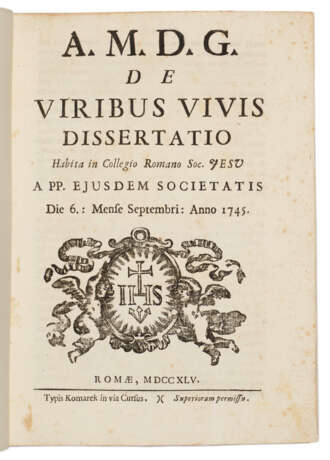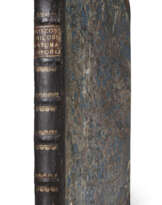ID 887782
Lot 9 | De viribus vivis dissertatio
Estimate value
$ 3 500 – 6 000
First edition, first issue of Boscovich’s earliest published work on his dynamic point theory, the first seeds of atomic physics. Boscovich’s dynamic point theory was "the first general mathematical theory of atomism" (Whyte); the present publication, on the living force (vis viva) is Boscovich's first statement of his universal source law. It was the precursor to his magnum opus, Philosophiae naturalis theoria, which was praised by Faraday, Maxwell, and Heisenberg. That work (see lot 11) "is now recognized as having exerted a fundamental influence on modern mathematical physics ... As the title of his book implies, he considered that a single law was the basis of all natural phenomena and of the properties of matter; that the multiplicity of physical forces was only apparent and due to inadequate mathematical knowledge" (PMM).
Inspired by the work of Leibniz and Newton, Boscovich came to a radically new understanding of the nature of physics. "In Boscovich’s natural philosophy the “first elements” of matter became mere points – real, homogeneous, simple, indivisible, without extension, and distinguished from geometric points only by their possession of inertia and their mutual interaction. Extended matter then becomes the dynamic configuration of a finite number of centers of interaction. Many historians have seen in Boscovich’s derivation of matter from forces an anticipation of the concept of the field, an anticipation still more clearly formulated very much later by Faraday in 1844. Matter, then, is not a continuum, but a discontinuum. Mass is the number of points in the volume, and drops out of consideration as an independent entity" (DSB). There are two issues of this publication, an academic one as here, and a commercial one, the latter containing a differing imprint and also naming Boscovich as the author. A comparison of the two makes clear that both were printed from the same standing type, apart from the title page. This copy has manuscript corrections to the text on pages V, IX, and XXXIX, as in the BSB copy. Riccardi I.1 174 n 21; Sommervogel I 1832 n 22; see PMM 203, Whyte in Roger Joseph Boscovich ... Studies of his life and work (1961).
Quarto (219 x 156mm). Folding engraved plates, woodcut Jesuit emblem on title (some light spotting). Later plain wrapper.
| Address of auction |
CHRISTIE'S 8 King Street, St. James's SW1Y 6QT London United Kingdom | |
|---|---|---|
| Preview |
| |
| Phone | +44 (0)20 7839 9060 | |
| Buyer Premium | see on Website | |
| Conditions of purchase | Conditions of purchase |





